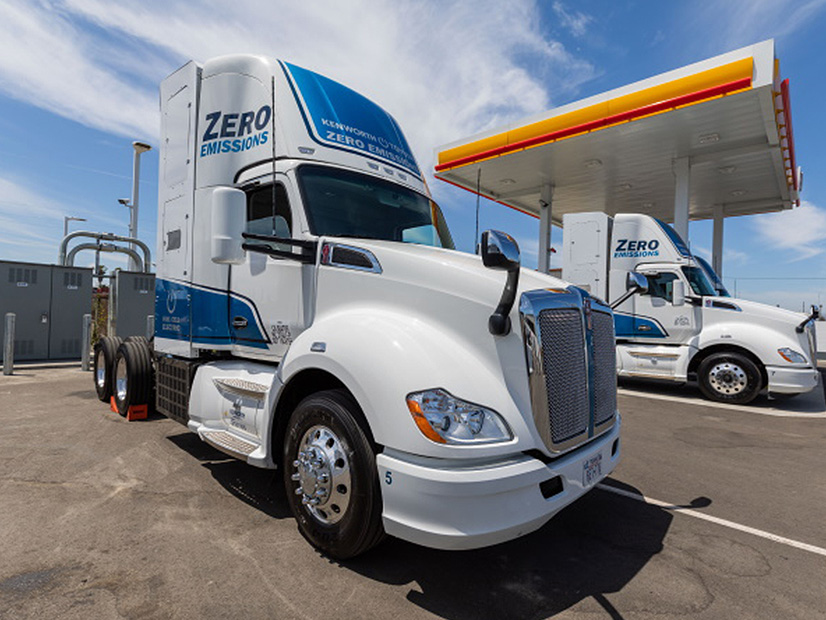
California’s hydrogen fueling network serving heavy-duty trucks needs to be expanded beyond seaports to sites throughout the state and even into neighboring states if California wants to meet its zero-emission vehicle goals, speakers said during a workshop.
Ports, where heavy-duty drayage trucks pick up containers for transport to nearby locations such as rail facilities or distribution centers, are seen as a good starting point for zero-emission heavy-duty trucks. (See Decarbonizing America’s Ports Could be 1st Step for Hydrogen Adoption.)
And hydrogen fuel cell electric trucks are being introduced at the Port of Los Angeles. In June, the port announced a demonstration project that will include 10 hydrogen fuel-cell heavy-duty trucks and two hydrogen fueling stations. The trucks will be used for local pickup, delivery and drayage near the port and short regional trips in the Inland Empire. (See Fuel Cell Semis Get Road Test at Port of Los Angeles.)
But the movement of goods doesn’t stop with drayage, and some say planning must include hydrogen fueling for heavy-duty trucks at sites farther afield.
“Focusing on California only initially may be a good thing for drayage,” said Nico Bouwkamp, technical program manager for the California Fuel Cell Partnership (CaFCP).
But freight operators “frequently have opportunities to move their freight out of state,” Bouwkamp said. “They need to be able to do that … otherwise they will not invest as much in the zero-emission trucks as they are expected to.”
The comments came during a California Air Resources Board (CARB) workgroup meeting on Dec. 16 that was held as part of the process for developing the Advanced Clean Fleets regulation. The meeting focused on issues related to hydrogen, including station location planning and timing.
Truck Stop Opportunities
The California Fuel Cell Partnership released a report in July titled “Fuel Cell Electric Trucks: A Vision for Freight Movement in California and Beyond.” The report from the industry group focuses on Class 8 tractors.
In developing a hydrogen-fueling network for heavy-duty trucks in California, the report says, initial efforts should focus on major freight hubs such as seaports, airports and large warehouse districts.
“The larger share of captive fleets with return-to-base operations in freight hubs will help optimize the utilization of hydrogen infrastructure, lowering fuel costs,” the report said.
The network can then be expanded by connecting the freight hubs along major corridors. California has about 500 public truck stops where some of the fueling stations could potentially be converted to hydrogen, the report said. Yet to be decided is which truck stops should be targeted first.
Working with neighboring states is also key “to reach[ing] high levels of zero-emission truck penetration in California and beyond,” the report said.
“The ports are … obviously a useful place for hydrogen,” Tim Sasseen, market development manager for Ballard Power Systems, said during the CARB workgroup meeting. “And the 5, 10, and 15 highways are going to be long-distance corridors as well. And mapping those out to existing commercial truck stops I think makes a heck of a lot of sense.”
Another meeting participant suggested looking at the West Coast Clean Transit Corridor Initiative, a partnership among electric utilities and agencies that studied how Interstate 5 from Mexico to the Canadian border could accommodate electric trucks.
The group’s report identified conceptual locations for 27 charging sites, spaced about 50 miles apart, for medium- or heavy-duty trucks. Perhaps some of those locations could also be hydrogen-fueling sites, the CARB workgroup participant said.
A California Transportation Commission representative noted during the workgroup meeting that the CTC is leading an assessment of freight corridors that would be good locations for zero-emission vehicle infrastructure, as well as potential projects to help transition to zero-emission freight. The assessment, which is a requirement of Senate Bill 671 of 2021, is due to the legislature by Dec. 1, 2023.
Advanced Clean Fleets
The Dec. 16 workgroup meeting was the second in a series of four sessions related to CARB’s Advanced Clean Fleets regulation.
The goal of the regulation is to accelerate the adoption of zero-emission trucks and buses by requiring fleets that are well-suited for electrification to transition to ZEVs where feasible.
According to CARB, the regulation would help reach the goals in Gov. Gavin Newsom’s 2020 executive order that calls for 100% zero-emission drayage trucks by 2035; and 100% zero-emission medium- and heavy-duty vehicles by 2045 where feasible.
CARB released an informal discussion draft of the regulation in September. Under the preliminary proposal, cities, counties, special districts and state agencies would be required to buy ZEVs when they add new vehicles to their fleets.
Starting in late-2023, CARB would allow only zero-emission drayage trucks to be added to its drayage truck registry. And by 2035, all drayage trucks would be required to be zero-emission.
Under the proposal, fleets designated as high-priority would be required to hit percentage-ZEV targets, starting with vehicle types that are most suitable for electrification. High priority fleets would include those of 50 or more vehicles, or those whose owner has $50 million or more in gross annual revenue.
The regulation would apply to vehicles weighing more than 8,500 pounds.
CARB has scheduled additional workgroup meetings for Advanced Clean Fleets on Jan. 12 and Jan. 19. The first of those sessions will focus on electricity and the grid; the second will focus on costs and funding.



